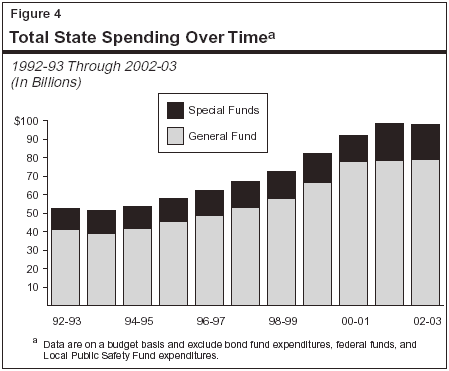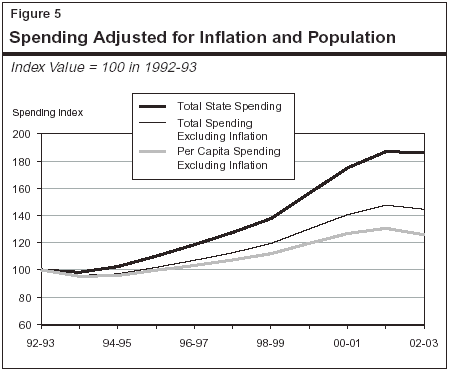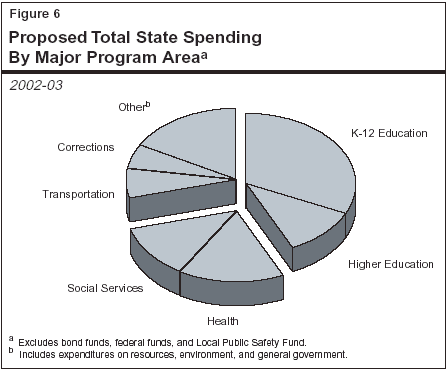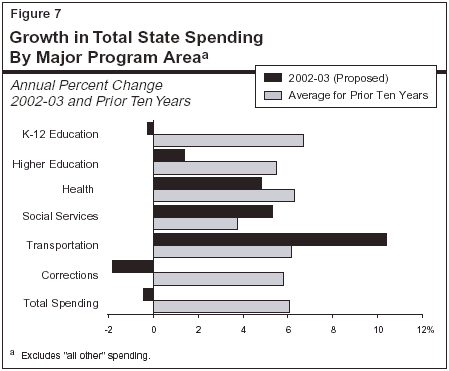Legislative Analyst's Office
The 2002-03 Budget Bill:
|
The Governor's budget proposes total state spending in 2002-03 of $97.9 billion, including spending from both the state's General Fund and its special funds (see Figure 1). Total budget-year spending is slightly less than estimated current-year spending—by $402 million (0.4 percent). Of total budget-year spending, General Fund spending accounts for slightly more than 80 percent.
|
Figure 1 Governor�s Budget Spending Totals |
||||
|
2001-02 and 2002-03 |
||||
|
|
|
|
Change |
|
|
|
2001-02 |
2002-03 |
Amount |
Percent |
|
Budget Spending |
|
|
|
|
|
General Fund |
$78,380 |
$78,806 |
$426 |
0.5% |
|
Special fundsa |
19,941 |
19,113 |
-828 |
-4.2 |
|
Totals |
$98,321 |
$97,919 |
-$402 |
-0.4% |
|
a Does not include Local Public Safety Fund expenditures of $2.2 billion in 2001-02 and $2.3 billion in 2002-03. These amounts are not shown in the Governor's budget. |
||||
|
Detail may not total due to rounding. |
||||
|
|
||||
Background. The General Fund is the predominate source of support for state programs, and thus finances a wide variety of activities. For example, it is the major funding source for K-12 and higher education programs, health and social services programs, youth and adult correctional programs, and tax relief.
The General Fund is primarily funded from tax revenues. As discussed in "Part III" of this volume, three large taxes are projected to account for nearly 90 percent of total 2002-03 General Fund revenues. These taxes are the state's personal income tax, sales and use tax (SUT), and bank and corporation tax.
Proposed Spending. Figure 2 summarizes General Fund spending in the prior, current, and budget years. In 2002-03, the Governor proposes General Fund spending of $78.8 billion. This is up a modest $426 million, or 0.5 percent, from the current-year's level. This growth rate is about the same as that for the current year and considerably slower than the exceptionally rapid growth experienced during the last half of the 1990s. The slow budget-year growth rate reflects a 0.2 percent decline in the General Fund portion of the Proposition 98 guarantee (about 40 percent of General Fund spending) and 1 percent growth in other programs (60 percent of spending).
|
Figure 2 General Fund Spending by Major Program Area |
||||
|
(Dollars in Millions) |
||||
|
|
|
|
Proposed 2002-03 |
|
|
|
Actual |
Estimated |
Amount |
Percent |
|
Education Programs |
|
|
|
|
|
K-12�Proposition 98 |
$27,229 |
$28,270 |
$28,582 |
1.1% |
|
Community colleges�Proposition 98 |
2,680 |
2,693 |
2,682 |
-0.4 |
|
UC/CSU |
5,644 |
6,166 |
6,104 |
-1.0 |
|
Other |
3,343 |
4,202 |
3,933 |
-6.4 |
|
Health and Social Services Programs |
||||
|
Medi-Cal |
$9,168 |
$9,705 |
$10,072 |
3.8% |
|
CalWORKs |
1,966 |
2,015 |
2,151 |
6.7 |
|
SSI/SSP |
2,555 |
2,821 |
3,049 |
8.1 |
|
Other |
6,121 |
7,181 |
7,169 |
-0.2 |
|
Youth and Adult Corrections |
$5,298 |
$5,372 |
$5,274 |
-1.8% |
|
All Others |
$14,050 |
$9,956 |
$9,790 |
-1.7% |
|
Totals |
$78,053 |
$78,380 |
$78,806 |
0.5% |
|
|
||||
Background. The special funds category involves a variety of components. Special funds generally are used to allocate certain tax revenues (such as gasoline and certain cigarette tax receipts) and various other income sources (including many licenses and fees) for particular functions or activities of government designated by law. Over one-half of special funds revenues come from motor vehicle-related levies. Other major funding sources include the SUT and tobacco-related receipts.
Proposed Spending. In 2002-03, the Governor proposes special funds spending of $19.1 billion (see Figure 3). This is $828 million, or 4.2 percent, less than the current-year estimated total of $19.9 billion. As indicated in the figure, this net reduction reflects an increase in transportation-related spending combined with more-than-offsetting reductions elsewhere. Specifically:
|
Figure 3 Special Funds Spending by Major Program Area |
||||
|
(Dollars in Millions) |
||||
|
|
|
|
Proposed 2002-03 |
|
|
|
Actual |
Estimated |
Amount |
Percent |
|
Transportation |
$3,595 |
$5,993 |
$6,619 |
10.4% |
|
Local government subventionsa |
5,512 |
6,165 |
5,105 |
-17.2 |
|
Resources related |
1,535 |
1,905 |
1,742 |
-8.6 |
|
Public Utilities Commissionb |
84 |
1,477 |
1,300 |
-12.0 |
|
All others |
3,246 |
4,401 |
4,347 |
-1.2 |
|
Totals |
$13,972 |
$19,941 |
$19,113 |
-4.2% |
|
a Budget-year reduction reflects accounting changes involving vehicle license fee subventions to local governments. |
||||
|
b Amounts reflect several new Universal Service Telephone programs that came "on budget" in the current year. |
||||
|
|
||||
It should be noted that the budget's special funds spending data exclude expenditures from the Local Public Safety Fund—estimated at $2.3 billion in the budget year. Although we believe that such spending does constitute state spending, we do not include it in our figures so as to facilitate comparisons with the budget's figures.
In addition to the $97.9 billion of proposed 2002-03 spending from the General Fund and special funds, the budget also proposes $47.6 billion in spending from federal funds and another $2.1 billion from bond proceeds. If expenditures from bond proceeds and federal funds are included in total state spending, the 2002-03 spending level exceeds $147 billion.
Of the total funds that California receives annually from the federal government, about three-fourths goes directly to local governments and other recipients, while roughly one-quarter flows through the state budget. Of the $47.6 billion in federal funds flowing through the state budget in 2002-03, about $30 billion is for various health and social services programs, such as Medi-Cal, California Work and Responsibility to Kids (CalWORKs), and In-Home Supportive Services (IHSS). Education receives another $11 billion of the total (split fairly evenly between K-12 and higher education), and transportation is expected to receive slightly less than $4 billion during the year.
New Federal Funds Assumed. The Governor's budget assumes that $1.1 billion in new federal funding will be received over the current and budget years. This includes $400 million in 2001-02 to offset the costs of Medi-Cal services, $350 million for security and bioterrorism funding, and around $180 million due to a waiver of federal penalties imposed due to delayed implementation of a statewide automated child support system. The risks associated with both of these funding assumptions and the remainder of the federal funding increases assumed in the budget are discussed in "Part I" of this volume.
Budgetary Treatment. When the state relies on bond proceeds instead of direct appropriations to fund its capital outlay projects, the use of these proceeds is not itself reported as budgetary spending as it occurs. Rather, the debt service cost for principal and interest on the bonds is what is recorded as budgetary spending. For 2002-03, the budget's proposed General Fund debt service costs total $3.1 billion, including slightly under $2.6 billion for general obligation bonds and $556 million for lease-payment bonds.
Although this way of treating bonds makes sense from a budgetary standpoint, tracking bond fund expenditures themselves still is useful as an indication of the actual volume of "brick and mortar" activities going on in a given year with respect to capital projects.
Spending of General Obligation Bond Proceeds. The budget estimates that the state will spend $2.1 billion in general obligation bond proceeds for capital projects in 2002-03. This compares to $4.6 billion in the current year and $4.4 billion in the prior year. Of the proposed 2002-03 general obligation bond fund expenditures:
Spending of Lease-Payment Bond Proceeds. In addition to general obligation bonds, the state also uses lease-payment bonds to finance the construction and renovation of capital facilities. Lease-payment bonds do not require voter approval and their debt service is paid from annual lease payments made by state agencies (funded primarily through General Fund appropriations). The budget proposes slightly over $670 million in new lease-payment bonds in 2001-02 and 2002-03, which are part of the Governor's Economic Stimulus Package to accelerate new public works projects.
Background. In 1979, California's voters established a state appropriations limit (SAL) when they approved Proposition 4. The SAL places an "upper bound" on the amount of tax proceeds that the state can spend in any given year and grows annually by a population and cost-of-living factor. Most state appropriations are subject to the SAL; however, certain appropriations are exempt—including subventions for schools and local governments, capital outlay spending, and tax relief. If actual tax proceeds exceed the SAL over a two-year period, the excess must be divided among taxpayer rebates and Proposition 98 education funding.
SAL Not Currently Binding. Due to the economic downturn in the state's economy and its adverse effects on the state's revenues, the budget's proposed expenditures are well below the SAL in both the current and budget years. This is in contrast to recent years when rapid spending growth eroded the "room" under the limit until the SAL was finally exceeded, by $702 million, in 1999-00. (State appropriations fell well below the limit in 2001-01. Thus, the SAL's "excess revenue" provisions noted above did not take effect.)
The budget projects that appropriations subject to the limit will be $14.5 billion below the limit in the current year and $6.3 billion below the limit in 2002-03. The amount of room under the limit shrinks next year because tax proceeds are expected to grow by nearly 7.7 percent at the same time as the limit itself is expected to fall by 1.4 percent. (The latter decline is due to the effects of the recession on the per-capita income factor used to adjust the limit in 2002-03.)
Prior to looking at the programmatic details of the Governor's spending plan for 2002-03, we first provide a perspective on state spending by looking at how the new plan's spending amounts compare to historical trends.
Spending Trends and Their Determinants. Figure 4 shows the amounts of state General Fund and special funds expenditures since 199293. Their underlying trends and year-to-year variations are affected by a variety of factors. Generally, the most important factor tends to be the strength of the economy and the state revenues it generates to fund expenditure programs. However, decisions that policy makers and voters make also can have major effects on spending levels. One example is voter approval of Proposition 10 in 1998, which raised cigarette and tobacco taxes. Another example involves the numerous decisions made by the Governor and Legislature in recent years about how to allocate the state's large revenue increases between (1) tax relief and new spending, and (2) one-time and ongoing purposes.
Upward Trend to End. Figure 4 indicates that the modest decline in total state expenditures that is proposed in the Governor's budget is the first such fall-off since 199394. It also shows that expenditures have nearly doubled over the past ten years and that over two-thirds of this total growth has occurred since 199798. This growth was facilitated by the state's especially strong revenue performance during the latter part of the 1990s, driven by its robust economy and the stock market's gains.

Symmetrically, the budget-year's slight proposed decline reflects the current softness in California's revenue performance, caused by the recession and sharp drop in capital gains and stock-option income.
Components of Past Growth. Figure 5 breaks out the causes for the state's expenditure growth over the past ten years according to its three principal components—inflation in the costs of providing public services, population growth, and "real" growth in state programs. It indicates that:

Figure 6 shows the allocation of the proposed $97.9 billion of total state spending in 2002-03 among the state's major program areas. Both General Fund and special funds expenditures are included in order to provide a meaningful comparison of state support among broad program categories, since special funds provide the bulk of the support in some areas (such as transportation).

The figure shows that K-12 education receives the largest share of total spending—about one-third. (It should also be noted that K-12 education receives additional funding from local sources.) When higher education is included, the education share rises to over 43 percent. Health and social services programs account for about 28 percent of proposed total spending, while transportation and corrections together account for roughly 12 percent. In the "all other" category (17 percent), the largest share is for general-purpose fiscal assistance provided to local governments in the form of shared revenues and General Fund payments that backfill local losses from the recent VLF reductions.
In order to gain a perspective on changes in total state spending by program area, Figure 7 shows proposed 2002-03 program-by-program growth compared to such growth over the past ten years. It indicates that:

Given the multibillion-dollar budget shortfall that the Governor's proposed spending plan attempts to address, program expansions and new initiatives are limited in the new budget. However, the Governor does propose at least some of these, and funding levels for many key programs are maintained.
Most of the Governor's new proposals and augmentations are discussed in detail in our accompanying Analysis of the 2002-03 Budget Bill. Below, however, we provide a general overview discussion of the Governor's key General Fund spending proposals as previously summarized in Figure 4 of "Part I" of this document. A more detailed discussion follows in the next section entitled "Major Expenditure Proposals in the 2002-03 Budget."
Proposition 98 allocations to K-12 schools (which include local property tax revenues) total $41.2 billion in 2002-03. This represents an increase of $1.2 billion, or 3.1 percent, over the Governor's current-year estimate. This current-year estimate includes significant reductions proposed by the Governor in November. (Most of these reductions have been adopted by the Legislature in the Third Extraordinary Session.) Relative to the level of funding approved in the 2001-02 Budget Act, the proposed spending level for 2002-03 represents an increase of $734 million, or 1.8 percent. The budget proposes Proposition 98 resources of $7,058 per pupil for 2002-03. This represents an increase of 2 percent relative to the revised current-year estimate and 0.8 percent relative to the 2001-02 Budget Act amount.
Spending to Equal Minimum Required Amount. Unlike in recent years when the Proposition 98 minimum funding guarantee has been overappropriated, the budget proposes Proposition 98 spending equal to the minimum funding requirement. Within this amount, the budget provides $843 million for a 2.15 percent cost-of-living adjustment (COLA) for revenue limits and most categorical programs. The budget also provides $438 million for statutory growth, based on projected statewide attendance growth of 1.07 percent. In addition, the budget proposes several program augmentations, and also provides ongoing funds for various programs funded in the current year with one-time monies. To offset these augmentations, the budget for K-12 education relies on current-year and budget-year reductions to various existing programs.
Community Colleges. The budget proposes $4.7 billion in Proposition 98 funding for California Community Colleges. This represents an increase of 3 percent over the current year. This increase includes support for 3 percent growth in enrollments and a 2.15 percent COLA. The General Fund component of Proposition 98 funding is reduced by 0.4 percent due to an anticipated increase in local property taxes.
UC and CSU. Here, the budget proposal includes a combined 2002-03 General Fund reduction of 1 percent, comprised of a 2.5 percent reduction for UC and an increase of about 1 percent for CSU. (The overall decline is due to one-time expenditures in the current-year budgets for both segments.) These budgets support a 1.5 percent general increase and 4 percent enrollment growth for both UC and CSU.
The Governor's budget proposes to postpone payment of the state's retirement contributions to the Public Employees' Retirement System (PERS) and the State Teachers' Retirement System (STRS) in exchange for the administration's support of particular retirement benefit enhancements. Specifically, in exchange for lowering the state's PERS contributions earlier than scheduled, the administration has agreed to support legislation that increases future payments to retirees that provide purchasing power protection at 80 percent instead of 75 percent of the initial pension amount, effective January 1, 2005. The provisions of the STRS agreement have not been finalized.
Health Programs. In the Medi-Cal program, the budget includes proposals for certain spending reductions, including reforms in the way drugs are purchased and provided to patients ($100 million), cuts in provider rates ($78 million), and establishment of copayments for certain patients ($31 million). The budget also assumes that expansion of the Healthy Families Program to parents—initially slated to start in the current fiscal year—will be postponed until 2003-04. (Following recent approval of a federal waiver, however, the Governor has indicated support for the expansion to occur in the budget year.)
Social Services. The budget proposes to suspend statutory COLAs for CalWORKs and SSI/SSP, and does not provide the discretionary COLA for Foster Care and related programs. The budget also provides no inflation adjustment for county administration of CalWORKs, Foster Care, or Food Stamps. The Governor also proposes to reform California's subsidized child care system by modifying current eligibility rules, reimbursement rate limits, and family fees.
Youth and Adult Corrections. The budget proposes reduced General Fund spending for the California Department of Corrections and the Department of the Youth Authority due to reduced inmate and ward popu lations, respectively. In addition, the budget proposes savings from deactivating some community correctional facilities and shifting General Fund support for some programs to Workforce Investment Act funds.
Transportation. The budget proposes to loan $672 million from the Transportation Congestion Relief Fund (TCRF) to the General Fund. This amount is in addition to the $238 million transferred in the current year from the TCRF to the General Fund. The budget anticipates that the General Fund will repay the TCRF loans over a three-year period beginning in 2003-04.
Local Government. The budget does not change major local government subventions provided by the state, including those associated with the property tax and vehicle license fee. Existing criminal justice grant programs, such as the Citizens' Option for Public Safety and technology grant programs, are continued. Certain proposals of the Governor regarding state-county health and social services programs may increase county costs.
Capital Outlay. The budget includes $1.7 billion for capital outlay projects, of which the vast majority are financed from bonds. Included in this total are new lease-payment bonds for the Governor's Economic Stimulus Package to accelerate new public works projects. Direct General Fund appropriations for capital outlay total $66 million.